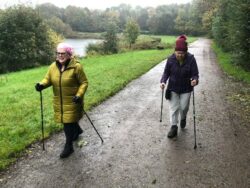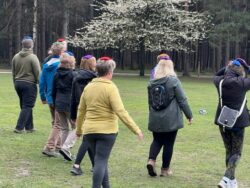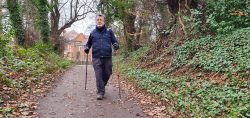By Gill Stewart at
When faced with a long term condition or lack of mobility, it can be daunting to find the right kind of support and care when it comes to being active regularly. Immediately after an injury or diagnosis, most people get fantastic support from Physiotherapists and Occupational therapists, many with specific areas of expertise from neurological conditions and osteopathy to stroke or cardiac rehabilitation.
Through our work with such teams we see daily what a difference they can make to both physical and mental recovery or improvement. Some are also in a position to provide regular activity sessions for the cohort they work with whilst others only see them for a short amount of time before signposting them to exercise referral teams or similar.
Both the professionals and their patients tell us that finding opportunities for regular exercise in a supported environment where their rehabilitation, recovery or management of a condition is taken into account, is often difficult. That’s why we like to link our community groups up with local clinics, hospitals and independent suitably qualified Instructors in our network. Each one has a part to play when it comes to providing the correct exercise and motivation so signposting people back and forth is invaluable.
 Martin Christie from WALX explains
Martin Christie from WALX explains
” We provide training for the professionals to use poles specifically for their cohort of patients but we also take time to ensure they can help those people to continue to benefit from being more active longer term. In some cases like the St Johns Therapy Centre in London, the team set up a peer led pole walking group that people could come to each week, others signpost to a local leisure centre, charity group or similar where the patient can continue to enjoy pole walking with those we have trained as WALX community Guides.”
We also see a great deal of self referral from those who have discovered poles during their rehabilitation and wish to continue it. Joining a group who provide sociality, variety and progression is invaluable and is also something that professional clinics can not always manage. There is a huge difference between providing a one hour pole walking session from a clinic, surgery or centre to providing a schedule of walks at different locations, levels and lengths. That’s why our network of WALX Masters and Instructors who make it their business to provide a range of inspirational sessions are a vital link in this chain of continued physical activity. Working together, Clinical, community and independent groups can deliver so much more. The Ladies in the picture above are part of the Parks and Pathways nordic walking group in Manchester.
 At WALX we want to help people walk well, use poles and stay on their feet well into older age! We know that to do that, it helps to link up with the professionals that can provide that all important initial intervention. Those seeking walking based solutions can find out more about our clinical partners HERE and community projects HERE. They can also choose from thousands of walks a week via the WALX portal which ensures they are able to select walks at the right level for them. We have comprehensive health screening that also ensures they will only walk with suitably qualified leaders who are also trained to liaise with the professionals when necessary.
At WALX we want to help people walk well, use poles and stay on their feet well into older age! We know that to do that, it helps to link up with the professionals that can provide that all important initial intervention. Those seeking walking based solutions can find out more about our clinical partners HERE and community projects HERE. They can also choose from thousands of walks a week via the WALX portal which ensures they are able to select walks at the right level for them. We have comprehensive health screening that also ensures they will only walk with suitably qualified leaders who are also trained to liaise with the professionals when necessary.
 A great place to start are our wellness sessions which combine walking well with mobility, balance, strength and CV exercises. Here is a great example of how this approach worked for Nick who has COPD and was referred by his specialist. His final phrase reinforces the importance of providing opportunities for people to find motivating, sociable sessions.
A great place to start are our wellness sessions which combine walking well with mobility, balance, strength and CV exercises. Here is a great example of how this approach worked for Nick who has COPD and was referred by his specialist. His final phrase reinforces the importance of providing opportunities for people to find motivating, sociable sessions.
I joined WALX HAMPSTEAD and at first I was slow and tentative. I was easily exhausted. But I quickly discovered that walking with the two poles actually gives you the power of a quadruped. Your arms provide as much motive power as your legs. So your upper body is slowly strengthened, just as your legs and lungs are. You are upright, feeling your body working, but not in a muck sweat. You can look around at the trees, admire the light, smell the plants, listen to the birdsong, even chat to your neighbour walkers. (It is a lot more social than jogging eight miles while listening to a podcast on your headphones.)
During lock down I decided to take my poles and walk the local streets. My wife came with me. She had noticed that I was getting a little stronger, was taking a little longer to get tired. I gave her a set of poles for her birthday. (She was very chuffed!) So now we swung through the quiet streets side by side each day
I can now walk for an hour over uneven ground and only feel pleasantly tired at the end of the exertion. With COPD, I’ll never be able to join a serious powered walking group that can tramp over 30 miles of rough ground in a day and drink beer at the end of it. But equally I know well that I can confidently recommend using poles as an activity to anyone at all and especially to anyone who feels themselves a little weakened by age or ill-health.
In sum: Pole Walking with my strapless poles strengthens the body, clears the mind, promotes friendships and even, at times, tickles the intellect. It does not require a great range of expensive kit. And you can definitely enjoy a coffee and a biscuit (or a pint) at the end of a session if you are of a mind to… “
If you would like to learn more about walking programmes for those with medical conditions, rehabilitation or general mobility contact Gill@walx.co.uk
To link up with your local group who can provide safe regular classes at the right level – visit our portal and pop in your postcode. Search for WELLNESS sessions or by group in order to speak to the local leaders.